
The Boston-area trolleybus system formed part of the public transportation network serving Greater Boston in the U.S. state of Massachusetts. It opened on April 11, 1936, with a large network operating for the next quarter-century. Measured by fleet size, the Boston-area system was the second-largest trolleybus system in the United States at its peak, with only the Chicago system having more trolleybuses than Boston's 463. After 1963, the only remaining portion was a four-route cluster operating from the Harvard bus tunnel at Harvard station, running through Cambridge, Belmont, and Watertown. The Massachusetts Bay Transportation Authority took over the routes in 1964.
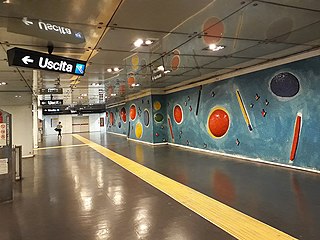
The Naples Metro is a rapid transit system serving the city of Naples, Campania, Italy and some parts of the adjacent comuni of its metropolitan area through Line 11. The system comprises four underground rapid transit lines.

The Naples tramway network is located within the city and comune of Naples, in the region of Campania, southern Italy. In operation since 1875, the network has waxed and waned in size and vitality over the years, and is now growing once again. It is now 11.8 km (7.3 mi) long, and comprises three routes, known as lines 1, 2 and 4.

The Rome trolleybus system forms part of the public transport network of the city and comune of Rome, Italy. In operation since 2005, the current system comprises three routes.
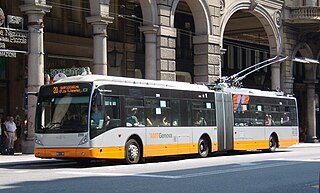
The Genoa trolleybus system forms part of the public transport network of the city and comune of Genoa, in the region of Liguria, northern Italy. In operation since 1997, the system currently comprises only one route. Between 2008 and 2012, two routes were being operated.
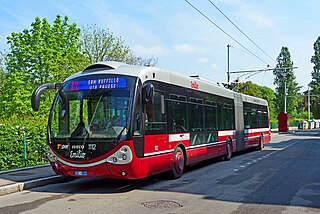
The Bologna trolleybus system is part of the public transport network of the city and comune of Bologna, in the region of Emilia-Romagna, northern Italy. While being in operation since 1991, the current system comprises five urban routes: 13, 14, 15, 32 and 33. Additional routes are presently under construction.
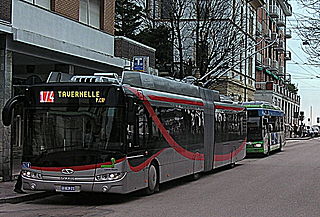
The Ancona trolleybus system forms part of the public transport network of the city and comune of Ancona, in the Marche region, central Italy. In operation since 1949, the system presently comprises only one urban route.

The Modena trolleybus system forms part of the public transport network of the city and comune of Modena, in the region of Emilia-Romagna, northern Italy.

The Santos trolleybus system forms part of the public transport network in Santos, a municipality in the state of São Paulo, Brazil. Opened on 12 August 1963, it presently comprises only one line, and, along with the two São Paulo metropolitan area trolleybus systems, is one of only three trolleybus systems still operating in Brazil.

The Philadelphia trolleybus system forms part of the public transportation network serving Philadelphia, in the state of Pennsylvania, United States. It opened on October 14, 1923, and is now the second-longest-lived trolleybus system in the world. One of only four such systems currently operating in the U.S., it presently comprises three lines and is operated by the Southeastern Pennsylvania Transportation Authority (SEPTA), with a fleet of 38 trolleybuses, or trackless trolleys as SEPTA calls them. The three surviving routes serve North and Northeast Philadelphia and connect with SEPTA's Market–Frankford rapid transit line.

The Rimini trolleybus system forms part of the public transport network of the Province of Rimini, in the region of Emilia-Romagna, Italy.
Azienda Napoletana Mobilità SpA, more commonly known simply as ANM, is a municipally controlled public company that is the primary provider of urban public transportation in the city of Naples, Italy, and also provides a portion of the surface transit service in surrounding municipalities. In addition to a network of tram, trolleybus and motorbus routes, ANM operates the Naples Metro system and four urban funiculars. The metro system and funiculars were operated by a different company from 2001 to 2013, when they again became part of ANM.

The La Chaux-de-Fonds trolleybus system forms part of the public transport network in La Chaux-de-Fonds, in the canton of Neuchâtel, Switzerland.
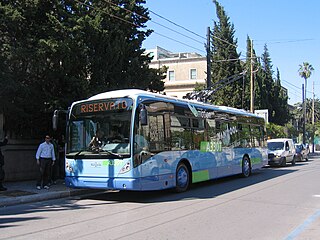
The Lecce trolleybus system forms part of the public transport network of the city and comune of Lecce, in the Apulia region, southern Italy.
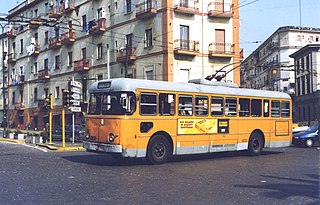
The Alfa Romeo Mille is a trolleybus manufactured by Alfa Romeo.

Naples Metropolitan Railway service are two independent companies that operate a commuter rail system in Naples. The first one, Trenitalia, operates line 2 from Pozzuoli Solfatara to Gianturco station in East of Naples. The other one, EAV, operates the Circumvesuviana, Cumana, Circumflegrea and MetroCampania NordEst. In Italy, Naples is the only city possessing two independent metropolitan railway service companies.
Di Vittorio will be a station on Line 1 of the Naples Metro and on Line 11 of the railway network managed by EAV. It is located in the Secondigliano district, between Piazza Giuseppe Di Vittorio and Viale Comandante Umberto Maddalena.

The Avellino trolleybus system forms part of the public transport network of the city of Avellino and the province of Avellino, in the region of Campania. Trolleybuses originally served the city from 1947 to 1973, on a route that also extended outside the city to the neighbouring towns of Atripalda and Mercogliano, and then the system closed. However, in the 2000s work to build a new trolleybus system got under way and new vehicles were purchased for it in 2007, and were delivered in 2014. The project experienced several delays after the start of construction in 2009, but most issues had been resolved by 2020 and construction was largely completed by 2021. Throughout its planning and construction, it was inaccurately referred to as the "metropolitana leggera", when in fact it was never planned to be a rail line, and always planned to be a trolleybus line. The last round of testing took place in December 2022 and January 2023, and the new trolleybus system opened for service on 3 April 2023.























